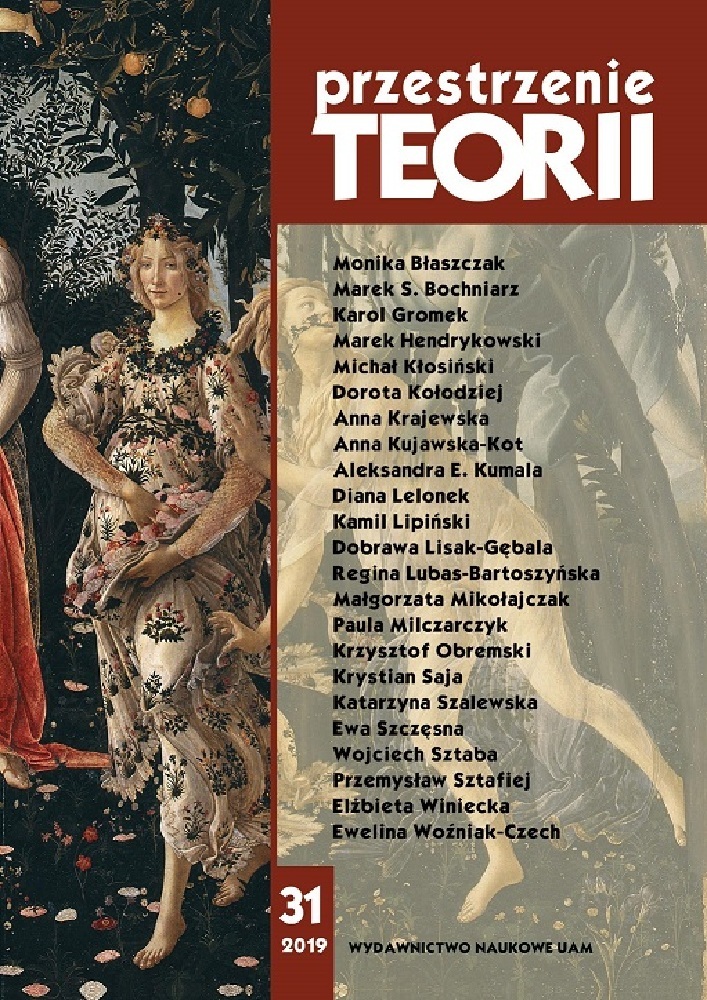Abstrakt
The aim of the article is to analyse the aesthetic aspects of the reception and creation of art by people with hearing impairments. For most people, hearing loss is unimaginable and is often understood only in the context of communication problems. Meanwhile, deaf people perceive their otherness completely differently. Deafness is a total experience, affecting not only the physical aspect, but also changing the perception of reality as a whole. Divergences in the way of perceiving the world, resulting from the exclusion of one of the basic senses, are particularly visible in the field of art, especially in those areas that use sound effects. The large variety of types of deafness does not allow for broad generalizations or building some kind of universal theory of reception. Therefore, from the perspective of deaf people, contact with art is very individual and intimate, which also affects the issue of their artistic creation. The author of the article touches upon the problem of the visuality of sign language and its artistic possibilities. She analyses the perception preferences of people with hearing impairments, exposing the issue of polysensory perception, and presents the most interesting artistic projects created both by the deaf and those that allow to build multidirectional relations between the parallel worlds of the deaf and hearing people.
Bibliografia
Bazak A., Poezja migana, 2014, <https://www.youtube.com/watch?v=XxxpXwwgHwU> [dostęp: 15.11.2018].
Bazak A., „Żegluga”. Warsztaty poezji miganej, 2018, <http://literatura.wroclaw.pl/wydarzenia/zegluga-warsztaty-poezji-miganej/> [dostęp: 18.11.2018].
Berleant A., Prze-myśleć estetykę. Niepokorne eseje o estetyce i sztuce, przeł. M. Korusiewicz, T. Markiewicz, red. K. Wilkoszewska, Kraków 2007.
Czym jest pętla indukcyjna?, <https://petlaindukcyjna.pl/czym-jest-petla-indukcyjna/> [dostęp: 26.11.2018].
Dobrze, że jesteś, 2014, <https://www.youtube.com/watch?v=XlLKOeHwK7s> [dostęp: 26.11.2018].
Dunaj M., GŁUCHY-ŚWIAT. Głuchota w perspektywie antropologii zaangażowanej, Łódź 2015, <http://dspace.uni.lodz.pl/xmlui/bitstream/handle/11089/8015/dunaj-swiatgluchy-gluchota-w-perspektywie-antropologii-zaangazowanej.pdf?sequence=1&isAllowed=y> [dostęp: 20.11.2018].
Godlewska-Byliniak E., Odzyskiwanie obecności. Niepełnosprawność w teatrze i performansie, Warszawa 2017.
Greniuk A., Cisza pełna dźwięków, 2015, <http://www.niepelnosprawni.pl/ledge/x/251046> [dostęp: 26.11.2018].
<http://jezykowaoaza.pl/2015/03/jezyki-niezwykle-polski-jezyk-migowy/> [dostęp: 28.11.2018].
Kijewska A., Jak narysować dźwięk?, <https://www.vice.com/pl/article/mvz8dy/jak-narysowac-dzwiek> [dostęp. 16.11.2018].
Koczorowski O., Po wernisażu wystawy GAG w Katowicach, 2018, <http://www.gag.art.pl/2018/02/wernisazu-wystawy-gag-katowicach/> [dostęp: 16.11.2018].
Kowalski K., Architektura i rozwiązania techniczne, [w:] ABC Gość niepełnosprawny w muzeum, „Szkolenia Narodowego Instytutu Muzealnictwa i Ochrony Zbiorów” 2013, 2, <https://www.nimoz.pl/files/publications/17/ABC_Gosc_niepelnosprawny_lekki.pdf> [dostęp: 26.11.2018].
Legierska A., „Jeden gest”, reż. Wojciech Ziemilski, <https://culture.pl/pl/dzielo/jedengest-rez-wojciech-ziemilski> [dostęp: 10.11.2018].
Legierska A., Ziemilski: Jak zobaczyć głos, 2016, <https://culture.pl/pl/artykul/ziemilskijak-zobaczyc-glos-wywiad> [dostęp: 10.11.2018].
„Miganie pantoMimiczne – magia języka migowego” (Visual Vernacular), <http://pzg.warszawa.pl/miganie-pantomimiczne/> [dostęp:18.11.2018].
Napisy dla osób niesłyszących i słabosłyszących – zasady tworzenia, 2012, <http://dzieciom.pl/wp-content/uploads/2012/09/Napisy-dla-nieslyszacych-zasady-tworzenia.pdf> [dostęp: 20.11.2018].
Odziomek M., Dźwięk zaklęty w obrazach, czyli malarstwo zdobywczyni „artNobla 2015”, 2016, <http://katowice.wyborcza.pl/katowice/1,35018,19604370,dzwiek-zaklety-w-obrazach-czyli-malarstwo-zdobywczyni-artnobla.html> [dostęp: 16.11.2018].
Pakalska E., Niedoskonały odbiornik < https://pakalska.blogspot.com/2015/03/niedoskonay-odbiornik.html > [dostęp: 27.06.2019].
Poezja migana, <http://pzg.warszawa.pl/poezja-migana/> [dostęp: 25.11.2018].
Sacks O., Zobaczyć głos. Podróż do świata ciszy, przeł. A. Małaczyński, Poznań 1998.
Stępniewicz J., Bez znieczulenia. Recenzja „Plemienia” Myrosława Słaboszpyckiego, 2015, <https://kulturaliberalna.pl/2015/06/16/bez-znieczulenia-recenzja-plemienia-myroslawa-slaboszpyckiego/> [dostęp: 29.10.2018].
Szwoch G., Analiza dźwięków muzycznych, 2018, <https://sound.eti.pg.gda.pl/student/akmuz/02-Analiza.pdf> [dostęp: 16.11.2018].
Żórawska A., Gość z niepełnosprawnością słuchu w muzeum, [w:] ABC Gość niepełnosprawny w muzeum. Szkolenia Narodowego Instytutu Muzealnictwa i Ochrony Zbiorów, 2013, nr 2, <https://www.nimoz.pl/files/publications/17/ABC_Gosc_niepelnosprawny_lekki.pdf> [dostęp: 10.11.2018].
Licencja
Autorzy
Autorzy tekstów przyjętych do publikacji w czasopiśmie „Przestrzeniach Teorii” są zobowiązani do wypełnienia, podpisania i odesłania na adres redakcji umowy o udzielenie nieodpłatnej licencji do utworów, z zobowiązaniem do udzielania sublicencji CC.
Zgodnie z umową, autorzy tekstów opublikowanych w czasopiśmie „Przestrzeniach Teorii” udzielają Uniwersytetowi im. Adama Mickiewicza w Poznaniu niewyłącznej i nieodpłatnej licencji oraz zezwalą na użycie sublicencji Creative Commons Attribution-NonCommercial-NoDerivatives 4.0 International (CC BY-NC-ND 4.0).
Autorzy zachowują prawa do dalszego, swobodnego rozporządzania utworem.
Autorzy, którzy wykorzystują w swoim tekście cudze utwory (np. ilustracje, fotografie) proszeni są o dostarczenie do redakcji czasopisma zgodę na publikację od uprawnionych podmiotów.
Użytkownicy
Zainteresowani użytkownicy internetu uprawnieni są do korzystania z utworów opublikowanych po 2015 roku „Przestrzeniach Teorii” tylko w calach niekomercyjnych, pod następującymi warunkami:
- uznanie autorstwa - obowiązek podania wraz z rozpowszechnionym utworem, informacji, o autorstwie, tytule, źródle (odnośniki do oryginalnego utworu, DOI) oraz samej licencji;
- bez tworzenia utworów zależnych - utwór musi być zachowany w oryginalnej postaci, nie można bez zgody twórcy rozpowszechniać np. tłumaczeń, opracowań.
Do wszystkich tekstów opublikowanych przed 2015 r. prawa autorskie są zastrzeżone.
Inne
Uniwersytet im. Adama Mickiewicza w Poznaniu zachowuje prawo do czasopisma jako całości (układ, forma graficzna, tytuł, projekt okładki, logo itp.).
